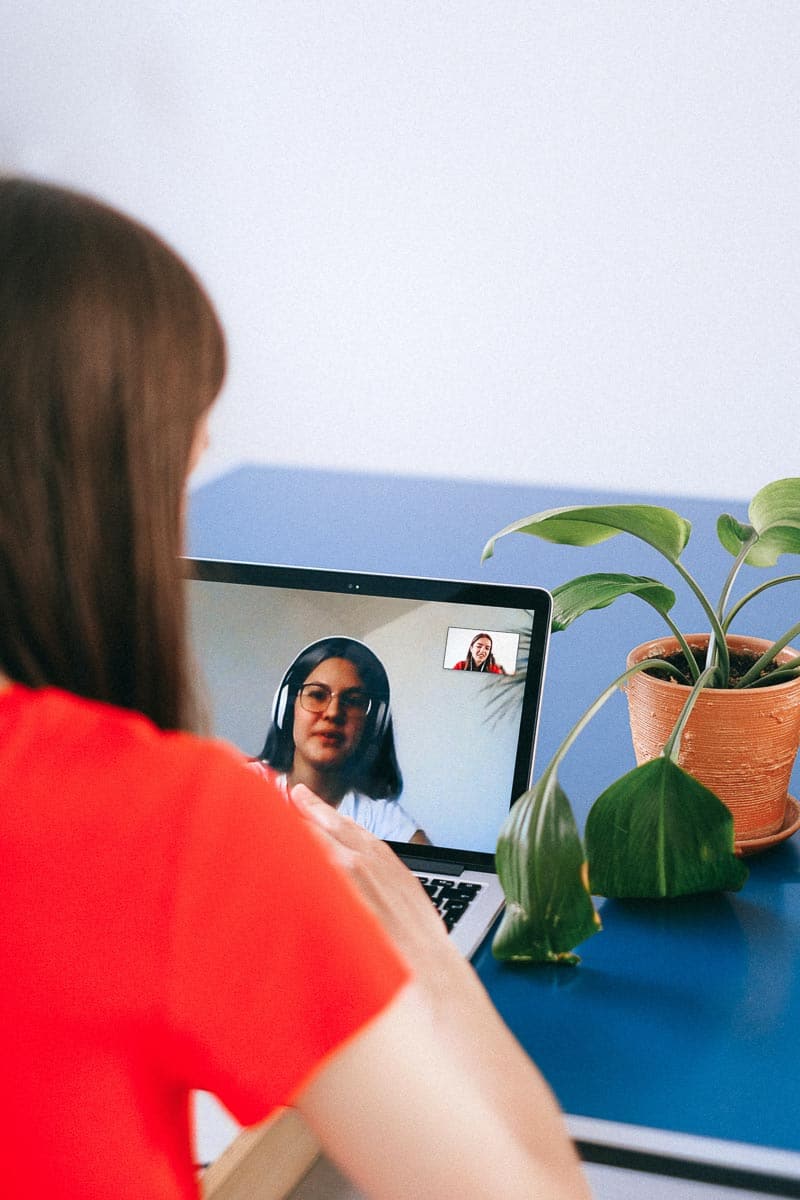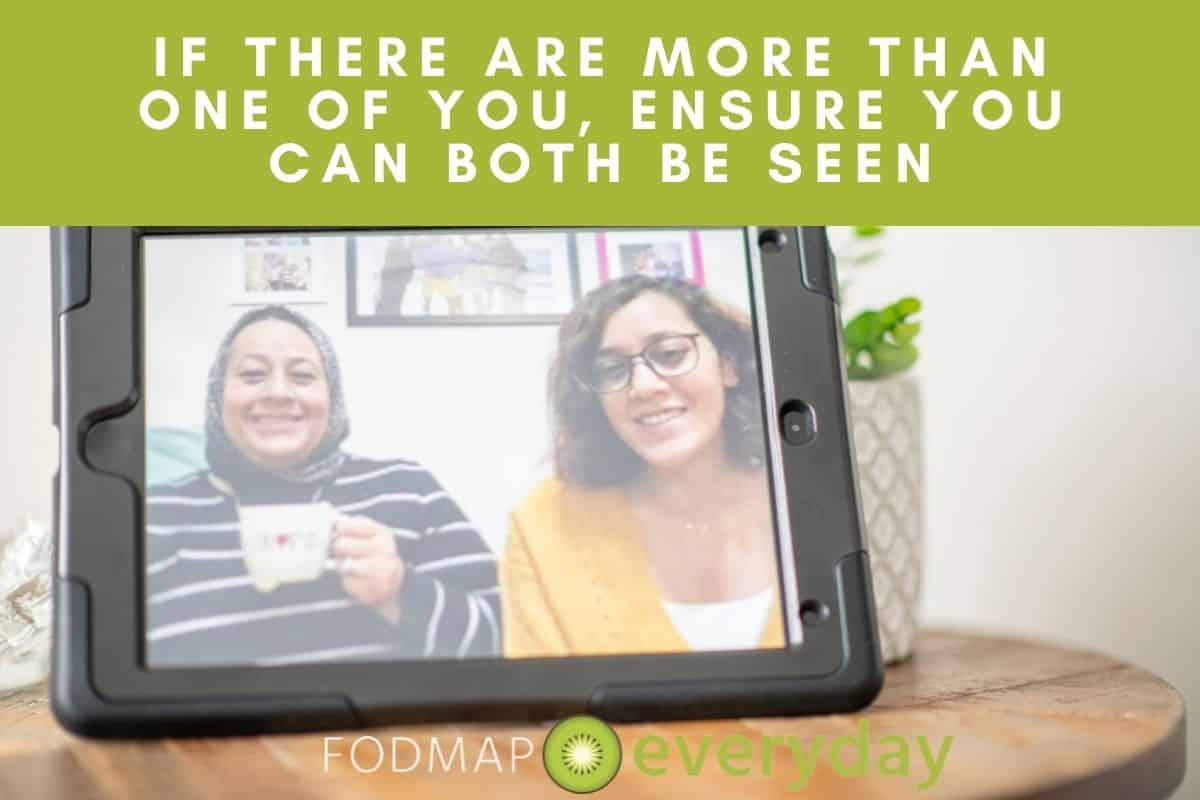More and more medical appointments are happening via Zoom, Skype, phone and through other virtual connections, which we think is great: more doctors, dietitians and medical personnel are now accessible to more people. You don’t even need to be in the same country! This article will help you get the most out of your telehealth appointment.

Digestive Issues & The Low FODMAP Diet
Since our main focus is helping those with IBS and following the low FODMAP diet, our article will focus on the kind of interactions that would happen around these issues. While some of this is basic information that will be helpful with any remote medical meeting, our intention is to help those who are following the low FODMAP diet and who have digestive issues.
Finding The Right Match
Usually when we research a doctor or medical professional, in addition to their credentials and demeanor, we think of convenience and how far we might have to travel for office visits. With telehealth, all you need is a good internet connection! Many Registered Dietitians are conducting remote visits these days.
You might find our article Dietitians vs. Nutritionists: What’s The Difference? of interest. Along with How To Choose A Dietitian you should have all the guidance you need to find the right person to work with.

Registered Dietitians & The Low FODMAP Diet
Monash University researchers, the developers of the low FODMAP diet, recommend undertaking the diet along with the guidance of a FODMAP trained registered dietitian (or equivalent in your country). Our team of RDs, most of them Monash University trained, concur.
Anecdotally, and statistically, you have a greater chance of success with the diet if you work with a registered dietitian. It can literally be the one decision that makes the difference between success and spinning your wheels (or not getting anywhere).
We strongly recommend that all of you work with a dietitian, and that they are Monash University trained. Many of them engage in telehealth.
You can use our Global Registered Dietitian Directory to find the right dietitian for you.
Thank you to RDs Jody Garlick, Marnie Nitschke, Tamara Duker Freuman, Diana Reid, Kathryn Adel, Vanessa Vargas and Rachelle Mallik for your fabulous input on how we can all get the most out of our telehealth appointments. Thank you also to the physicians and dietitians who are members of our Low FODMAP for Foodies Facebook Group for their ideas.
Preliminary Research
Let’s look at the similarities and differences when preparing for a telehealth appointment.
Here is what is the same:
- Know what and who your insurance covers
- Verify credentials and experience of the medical professional you have chosen
- Use personal references
- Plan on having an initial meeting, to assess whether you like them and feel comfortable, before engaging in a longer-term treatment plan
- Don’t settle for what doesn’t feel right
Here is how telehealth is different:
- Find out specifically what your insurance covers for telehealth appointments, which could vary from in-office visits: if you know you want to speak with a dietitian, find out specifically if that is covered or out-of-pocket
- Don’t worry about distance – unless there are insurance reasons – and double check this point
- If you are out-of-pocket, or insurance is broad, do not overlook international appointments!
- Realizing that geography is not a limiting factor can open up a world of possibilities for you.
- Once you have chosen a practitioner, double check with their office that their payment information matches what you learned from your insurance company
- It is literally easier to show up for your appointment! Even if it is raining or snowing, you can just turn on the computer, or pick up the phone
Now Get Ready For Your Appointment
Once you have chosen a medical professional, we want to help you be as prepared as possible for your appointment to maximize your time, the professional’s time, and get the best results from the remote meeting.
Our Team of RDs are in the trenches with all of you. They have heard it all and can help you get to the bottom of your digestive woes – but they ask that you help them, help you!
Straight from their mouths – specific ideas from our RDs – and yes, the “don’ts” are situations our RDs have experienced! Let’s all be good patients; it will only benefit ourselves in the long run.

DOs
- Make sure you have a good internet or phone connection
- Be sure to complete paperwork if provided. If you haven’t completed your privacy form, your appt might be rebooked & you may get a cancelation fee if it’s last minute
- Log in early and double check your tech on the device you will be using (sometimes systems work on a desktop or laptop, but not tablet or phone – or vice versa)
- Wear clothing: apparently this must be said (don’t ask)

- Minimize distractions: this includes babies, small children and pets
- Exceptions for postpartum and breastfeeding Moms! We know your babies will be near
- Write down your questions beforehand
- Have any pertinent medical documents at hand to share
- Be ready to take notes
- Consider keeping a food and symptom diary for a week or two prior to your appointment, so you can review with your dietitian during your consultation.
- Some RDs will have you fill out a questionnaire beforehand; please follow through if asked

- Alternatively, your food and symptoms log could be emailed prior to the visit; ask if this is possible
- As vital signs aren’t collected during TeleHealth visits, it is helpful when patients have their most recent weight and blood pressure (even if it is from the machines at the pharmacy).
- Have your supplements ready so we can check ingredients for FODMAPs etc. as well as any processed foods that you are not sure about
- Ask your clinician if they would be willing to share a synopsis with you if it includes action items for you to follow up on – they have to write visit notes anyway, so it isn’t a big ask.

DON’TS
- Don’t attend the meeting while driving – or boating (yes, this happened)!
- And especially do not drive and vape at the same time

- Please do not come to your appointment while food or clothes shopping – or doing any kind of shopping!
- Don’t be lying in bed in your PJs; if you are sitting up at a desk or similar, you will have better attention and concentration
- Don’t plan on doing your consultation at work if you have a shared office or cubicle. There’s a lot of poop talk about to happen
- Physicians and medical professionals are required to abide by HIPAA, and it just feels wrong when you can see strangers walking around in the background
- Turn off message alerts to avoid disruptive dinging from smartphones and computers
- If you also have a landline in the house, unplug that phone
- Avoid scheduling consults when you’re expecting visitors.
- Quit the multitasking!
- When thinking about your set up, try to have the light on your face (e.g., facing a window) rather than sitting with light behind you. The medical professionals want to see you!
- If there are more than one of you, ensure you can both be seen (set the device further back) and are not having to jostle for position

- Avoid walking around the house with your computer/phone/tablet as this is really disruptive
- Unless you really have to, eating a meal during the consultation is not really okay…
Registered Dietitians To The Rescue
The low FODMAP diet is meant to be undertaken along with a Registered Dietitian (RD, or equivalent in your country). The diet is nuanced and complex; statistically and anecdotally you will have a greater chance of success if you work with one.
We have put together a series of articles called Working With A Dietitian to help you learn why you should work with a dietitian, how to find the right dietitian for you, the difference between dietitians and nutritionists, what to expect from working with one, tips for successful telehealth appointments, and more.
Please take the time to familiarize yourself with these articles and resources:
- Have IBS? Top Reasons To Work With A Dietitian
- The Role Of The Dietitian vs. The Gastroenterologist
- How To Choose A Dietitian
- IBS: Step-by-Step Guide From Diagnosis To Symptom Free Living
- Dietitians & Nutritionists: What’s The Difference?
- What If The Low FODMAP Diet Isn’t Working?
- Global Dietitian Directory
A Note on Telehealth Laws
We have updated this article as of January 2024. Telehealth laws are in flux, but we encourage both dietitians and patients to use The Center for Connected Health Policy as a resource. Initially it may seem as though you will not be able to find a dietitian who can work with you remotely, but we encourage you to not give up! As with any new health provider, it might take time to find the right one for you.
The Takeaway
The advent of telehealth visits has expanded the opportunities for patients to get the medical help they need. It is important to do some groundwork ahead of time, asking specific questions of your insurance company, and also readying yourself for the appointment technically and logistically. Our article, Have IBS? Top Reasons To Work With A Dietitian, will be very helpful to review.
This includes, but is not limited to, making sure your phone or Internet connection is working, that you have any and all documents at hand to refer to, that you have written down some questions ahead of time and also have a way to take notes. Minimize all distractions and do not multitask; you should not be walking, shopping, eating or doing anything other than engaging with your medical professional.
There is literally a world of medical professionals with whom you can connect via a telehealth appointment, and they can make the difference between you experiencing success with the low FODMAP diet, relieving yourself of IBS symptoms – or not finding relief.







